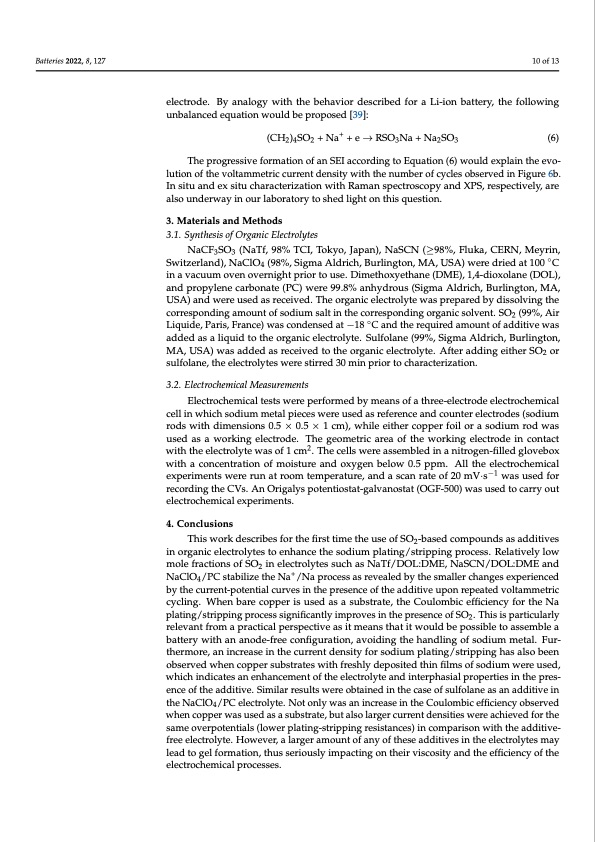
PDF Publication Title:
Text from PDF Page: 010
Batteries 2022, 8, 127 10 of 13 electrode. By analogy with the behavior described for a Li-ion battery, the following unbalanced equation would be proposed [39]: (CH2)4SO2 + Na+ + e → RSO3Na + Na2SO3 (6) The progressive formation of an SEI according to Equation (6) would explain the evo- lution of the voltammetric current density with the number of cycles observed in Figure 6b. In situ and ex situ characterization with Raman spectroscopy and XPS, respectively, are also underway in our laboratory to shed light on this question. 3. Materials and Methods 3.1. Synthesis of Organic Electrolytes NaCF3SO3 (NaTf, 98% TCI, Tokyo, Japan), NaSCN (≥98%, Fluka, CERN, Meyrin, Switzerland), NaClO4 (98%, Sigma Aldrich, Burlington, MA, USA) were dried at 100 ◦C in a vacuum oven overnight prior to use. Dimethoxyethane (DME), 1,4-dioxolane (DOL), and propylene carbonate (PC) were 99.8% anhydrous (Sigma Aldrich, Burlington, MA, USA) and were used as received. The organic electrolyte was prepared by dissolving the corresponding amount of sodium salt in the corresponding organic solvent. SO2 (99%, Air Liquide, Paris, France) was condensed at −18 ◦C and the required amount of additive was added as a liquid to the organic electrolyte. Sulfolane (99%, Sigma Aldrich, Burlington, MA, USA) was added as received to the organic electrolyte. After adding either SO2 or sulfolane, the electrolytes were stirred 30 min prior to characterization. 3.2. Electrochemical Measurements Electrochemical tests were performed by means of a three-electrode electrochemical cell in which sodium metal pieces were used as reference and counter electrodes (sodium rods with dimensions 0.5 × 0.5 × 1 cm), while either copper foil or a sodium rod was used as a working electrode. The geometric area of the working electrode in contact with the electrolyte was of 1 cm2. The cells were assembled in a nitrogen-filled glovebox with a concentration of moisture and oxygen below 0.5 ppm. All the electrochemical experiments were run at room temperature, and a scan rate of 20 mV·s−1 was used for recording the CVs. An Origalys potentiostat-galvanostat (OGF-500) was used to carry out electrochemical experiments. 4. Conclusions This work describes for the first time the use of SO2-based compounds as additives in organic electrolytes to enhance the sodium plating/stripping process. Relatively low mole fractions of SO2 in electrolytes such as NaTf/DOL:DME, NaSCN/DOL:DME and NaClO4/PC stabilize the Na+/Na process as revealed by the smaller changes experienced by the current-potential curves in the presence of the additive upon repeated voltammetric cycling. When bare copper is used as a substrate, the Coulombic efficiency for the Na plating/stripping process significantly improves in the presence of SO2. This is particularly relevant from a practical perspective as it means that it would be possible to assemble a battery with an anode-free configuration, avoiding the handling of sodium metal. Fur- thermore, an increase in the current density for sodium plating/stripping has also been observed when copper substrates with freshly deposited thin films of sodium were used, which indicates an enhancement of the electrolyte and interphasial properties in the pres- ence of the additive. Similar results were obtained in the case of sulfolane as an additive in the NaClO4/PC electrolyte. Not only was an increase in the Coulombic efficiency observed when copper was used as a substrate, but also larger current densities were achieved for the same overpotentials (lower plating-stripping resistances) in comparison with the additive- free electrolyte. However, a larger amount of any of these additives in the electrolytes may lead to gel formation, thus seriously impacting on their viscosity and the efficiency of the electrochemical processes.PDF Image | Sulfur Dioxide and Sulfolane Sodium Batteries

PDF Search Title:
Sulfur Dioxide and Sulfolane Sodium BatteriesOriginal File Name Searched:
batteries-08-00127-v2.pdfDIY PDF Search: Google It | Yahoo | Bing
Salgenx Redox Flow Battery Technology: Salt water flow battery technology with low cost and great energy density that can be used for power storage and thermal storage. Let us de-risk your production using our license. Our aqueous flow battery is less cost than Tesla Megapack and available faster. Redox flow battery. No membrane needed like with Vanadium, or Bromine. Salgenx flow battery
| CONTACT TEL: 608-238-6001 Email: greg@salgenx.com | RSS | AMP |